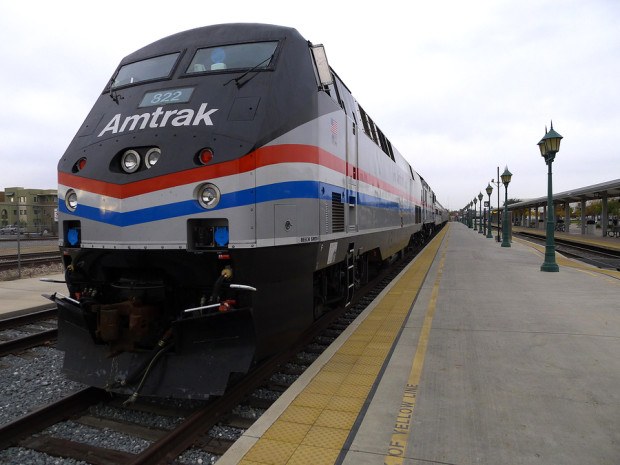Amtrak is getting $275 million of reinsurance protection from the capital markets for its wholly owned captive, covering storm surge, wind and earthquake perils, according to GC Securities.
GC Securities, the capital markets arm of reinsurance broker Guy Carpenter, announced the placement of the PennUnion Re Ltd. catastrophe bond shelf program on Wednesday, which benefits Passenger Railroad Insurance, Ltd. (“PRIL”), a Bermuda licensed and domiciled insurance company and wholly-owned subsidiary of the National Railroad Passenger Corporation (“Amtrak”).
“This is the first time Amtrak has used the capital markets to broaden our base of insurance coverage,” said Gerald Sokol, chief financial officer of National Railroad Passenger Corporation in a statement issued by GC Securites. “The catastrophe bond market provides us with a means to diversify our sources of insurance in a cost effective manner,” Sokol said.
The PennUnion Re Series 2015-1 Notes were popular with investors too.
Chi Hum, Global Head of ILS Distribution for GC Securities, said the offering was oversubscribed and had more than 25 participating capital market investors. Hum added that the strong support allowed the transaction size to be increased by 37.5 percent from the initial offering size, and that pricing was at the lowest end of price guidance.
Hum and other GC Securities representatives highlighted the appetite for diversifying perils, unique triggers structures and sponsor types.
The perils covered here are storm surge and wind resulting from Named Storms as well as earthquakes affecting the Northeast region of the U.S. for a period of approximately 3.17 years.
The per-occurrence protection has parametric triggers varying by peril; the triggers are based on key intensity measurements of physical parameters, such as water height and wind speed—with measurements are taken from both inland and offshore locations.
- Storm surge water height measurements are captured at seven tidal gauge stations in the Long Island Sound, East River, Lower New York Bay and Delaware River.
- Wind measurements are captured and interpolated for 60 ZIP codes along Amtrak’s Northeast Corridor (“NEC”) railways from Washington, D.C. to near Providence, RI.
- Earthquake intensity is interpolated to 21 ZIP codes within the states of Delaware, New Jersey, New York, Pennsylvania and Rhode Island.
Cory Anger, global head of ILS Structuring for GC Securities, noted that “The novel and dynamic trigger mechanisms based on physical observations for each of the perils covered…were tailored to specific losses to Amtrak’s infrastructure and are fairly unique in the current ILS landscape,” adding that the offering demonstrates “the applicability of ILS structures to public sector risks including on the federal level.”
David Priebe, vice chairman of Guy Carpenter, also highlighted the ability to offer capital markets-based risk transfer solutions beyond insurance company sponsors, reaching “corporate and quasi-governmental entities with critical infrastructure exposure” as well.
Indeed, during a recent video interview at the Rendez-Vous de Septembre, Priebe told Carrier Management that the use of capital markets solutions—insurance-linked securities, cat bonds, or collateralized reinsurance—is old hat for insurers. They have “now become embedded in many insurance company capital frameworks. Where five years ago it was novel—’Ooh, I’m going to try a cat bond and test it out’—now it’s become almost a part of the normal decision-making process that a company’s using in terms of accessing different forms of capital,” Priebe said.
“Now they’re at the point of saying, ‘What is the right form of capital?’ ‘What’s the lowest cost of capital?’ ‘What’s the right panel of capital partners to work with?'”
In the public sector, Amtrak is not the first entity to sponsor a catastrophe bond covering storm surge. The Metropolitan Transportation Authority in New York sponsored a storm-surge only bond in 2013.
For the public sector risks involved in the Amtrak placement, GC Securities served as joint structuring agent and joint bookrunner for the Series 2015-1 Notes.
Risk Management Solutions, Inc. served as modeling firm and calculation agent.
In a separate statement, RMS said that in addition to the risk analysis, RMS also provided consulting support to help Amtrak strengthen its risk transfer strategy. “Combined, the bond and preparatory consulting work by RMS equips Amtrak to define the probability and severity of potential catastrophic scenarios, assess the risk that it currently holds, and evaluate the cost benefit of disaster risk mitigation policies,” RMS said.
Ben Brookes, vice president of capital markets at RMS, noted that “the bond’s robust trigger, based on measured hazard values, will help Amtrak receive a quick settlement, enabling the agency to recover quickly following a hurricane or earthquake.”





















 Artificial Intelligence Is Rewriting the Rules for Commercial Lines
Artificial Intelligence Is Rewriting the Rules for Commercial Lines  Surge of Supercharged Hurricanes Prompt Call for Cat 6 Classification
Surge of Supercharged Hurricanes Prompt Call for Cat 6 Classification  Five AI Trends Reshaping Insurance in 2026
Five AI Trends Reshaping Insurance in 2026  Good Times for U.S. P/C Insurers May Not Last; Auto Challenges Ahead
Good Times for U.S. P/C Insurers May Not Last; Auto Challenges Ahead 
